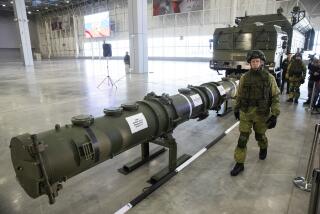State and Defense Departments Disagree on New Soviet Radars
WASHINGTON â A significant split has developed between the State and Defense departments over how to view three new, high-performance radars being built in the Soviet Union. And the outcome of the fight will probably have repercussions at the Geneva arms control talks, which resume this week, as well as on the future of the Anti-Ballistic Missile (ABM) Treaty.
The controversy is coming to a head with preparation of the annual report, mandated by Congress, on Soviet compliance with various arms treaties. The report was due Dec. 1 but has been delayed by the dispute over the radar issue and by White House preoccupation with the Iran- contra crisis and other matters.
The Pentagon wants to accuse the Soviets of moving significantly closer to constructing a nationwide anti-missile system, which is barred by the ABM treaty. The State Department prefers to remain with last yearâs more muted charge that the Soviets âmay be preparing an ABM defense.â
A new accusation of Soviet cheating, coming amid the troubled arms negotiating situation that has followed the U.S.-Soviet summit meeting in Reykjavik, Iceland, could be interpreted as a signal to the Soviets that the Administration is moving away from a new agreement rather than toward it, some officials contend.
Moreover, State Department officials said, charging the Soviets with constructing the basis of a national ABM defense--a defense that would violate the treaty--could set the stage for conservatives to call for the United States to discard the treaty first in all-out pursuit of an anti-missile shield envisaged by President Reaganâs Strategic Defense Initiative, or âStar Warsâ program.
At least it would make it more difficult for the Administration to compromise with the Soviets on the SDI and ABM issues in negotiations toward a new arms agreement, these officials added.
The radar issue surfaced publicly in November, when the CIA reported that three large phased-array radars (which are âsteeredâ electronically without mechanically rotating antennae) were being constructed near the Soviet Unionâs East European border, in Latvia, Byelorussia and the Ukraine. They are similar to six others around the Soviet periphery.
One of those existing radars, at Krasnoyarsk, is deep inside Soviet territory, contrary to the ABM treaty, which permits such radars only at the borders of each country and pointing outward. The Soviets claim that the radar is for space tracking, rather than for missile detection, but the United States has branded it a clear-cut violation of the treaty.
The other phased-array radars are not violations of the treaty due to their location, and they largely duplicate the coverage provided by 20-year-old radar. But the older radars are far less accurate, less far-ranging and less capable of identifying objects, according to both the CIA and Pentagon officials.
âBattle Managementâ Units
âThese new radars represent the kind of capability one would want in a radar network if one wanted to go to a national anti-ballistic missile network,â said a senior Pentagon official.
In such a network, the radars would operate as âbattle managementâ units--identifying, tracking and discriminating between warheads and other parts of attacking missiles and then passing the data to smaller radars, close to the various targets, which in turn would guide interceptor missiles at the incoming warheads.
âThese radars are far more capable than needed for just early warning (of attack),â the official added. âThey provide redundancy of radar coverage, which is also needed in an ABM network. And they move in the same direction of other Soviet activities in this field.â
The other activities include development of Soviet anti-aircraft missiles that can knock down some ballistic missiles as well; of a rapid reload capability for interceptors of the small Soviet anti-missile system permitted around Moscow; of rapidly deployable, mobile ABM radars, and of testing anti-aircraft systems with anti-missile systems, or ânetworking,â into what could become a single nationwide system.
More to Read
Sign up for Essential California
The most important California stories and recommendations in your inbox every morning.
You may occasionally receive promotional content from the Los Angeles Times.










